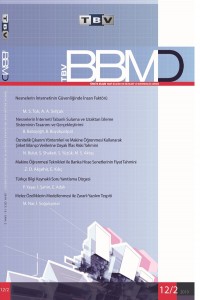Öz
Sulama
sistemleri, suyun akıllı bir şekilde yönetilmesi, sulama veriminin artırılması
ve kaynakların optimum şekilde kullanılmasını sağlamak amacıyla önemlidir.
Sulama sistemlerinde tipik koşulları temsil eden en önemli parametre toprak
nemi olmasına rağmen çevresel koşulların izlenmesi ile sulama veriminin
artırımı sağlanabilir. Bu çalışma
belirlenen alanda sulama ve uzaktan izleme sisteminin tasarımı ve
gerçekleştirimini ele almıştır. Çalışmanın gerçekleştirimi için kontrol
tarafında Arduino Uno mikrodenetleyici kart, ESP8266 Wi-Fi modülü, sensörler, su
motoru ile anahtarlama elemanı ve bulut tarafında ise ThingSpeak uygulama
programlama arayüzü (Application Programming Interface – API) kullanılmıştır.
Geliştirilen sistemde UV, yağmur, toprak nem ve sıcaklık sensörü yardımı ile
çevresel veriler mikrodenetleyici tarafından okunup Wi-Fi modülü kullanılarak
buluta kaydedilmiştir. ThingSpeak’te toplanan veriler gerçek zamanlı işlenerek
sulama sisteminin kontrolü ve çevrimiçi her yerden erişim imkanı sağlanmıştır.
Anahtar Kelimeler
Kaynakça
- [1] Tahakare S. and Bhagat P.H., Arduino-Based Smart Irrigation Using Sensors and ESP8266 Wifi Module, 2nd International Conference on Intelligent Computing and Control Systems (ICICCS 2018), pp. 1085–1089, Madurai, India, 2018.
- [2] Batte M.T., Changing computer use in agriculture: evidence from Ohio, Computers and Electronics in Agriculture, vol. 47, 1–13, 2005.
- [3] Al-Omary A., AlSabbagh H.M. and Al-Rizzo H., Cloud Based IoT for Smart Garden Watering System Using Arduino Uno, Smart Cities Symposium (SCS 2018), pp. 1–6, Melbourne, Australia, 2018.
- [4] Csótó M, Information flow in agriculture – through new channels for improved effectiveness, Agricultural Informatics Vol. 1, No. 2:25-34, 2010.
- [5] Na A., Isaac W., Varshney S. and Khan E., An IoT Based System for Remote Monitoring of Soil Characteristics, International Conference on Information Technology (InCITe), pp. 316–320, Pradesh, India, 2016.
- [6] Archana P. and Priya R., Design and Implementation of Automatic Plant Watering System, International Journal of Advanced Engineering and Global Technology, vol. 4(1), pp. 1567–1570, 2016.
- [7] Taştan M., Nesnelerin İnterneti Tabanlı Akıllı Sulama ve Uzaktan Sulama Sistemi, European Journal of Science and Technology, No. 15, pp. 229-236, 2019.
- [8] “Arduino Uno Nedir? Özellikleri ve Projeler”, https://maker.robotistan.com/arduino-uno/, [Erişim Tarihi: 15/10/2019].
- [9] “ESP8266 ve Arduino ile Nesnelerin İnterneti”, Hasbi Sevinç, Dikeyeksen yayıncılık, ISBN 978-605-4898-18-3, 2015.
Öz
Irrigation systems are important in order to manage water intelligently, increase
irrigation efficiency and ensure optimum use of resources. Although soil moisture
is the most important parameter representing typical conditions in irrigation systems,
monitoring of environmental conditions can increase irrigation efficiency. This study deals with the design
and implementation of irrigation and remote
monitoring system in the designated area. Arduino Uno microcontroller card, ESP8266 Wi-Fi module,
sensors, switching element with water motor and ThingSpeak application programming interface are used for the realization of the study. In the developed
system, environmental data is read by microcontroller with the help of UV, rain, soil moisture
and temperature sensor and recorded to cloud using Wi- Fi module.
The data collected in ThingSpeak is processed in real time, allowing
the control of the irrigation system and access from anywhere online.
Anahtar Kelimeler
Kaynakça
- [1] Tahakare S. and Bhagat P.H., Arduino-Based Smart Irrigation Using Sensors and ESP8266 Wifi Module, 2nd International Conference on Intelligent Computing and Control Systems (ICICCS 2018), pp. 1085–1089, Madurai, India, 2018.
- [2] Batte M.T., Changing computer use in agriculture: evidence from Ohio, Computers and Electronics in Agriculture, vol. 47, 1–13, 2005.
- [3] Al-Omary A., AlSabbagh H.M. and Al-Rizzo H., Cloud Based IoT for Smart Garden Watering System Using Arduino Uno, Smart Cities Symposium (SCS 2018), pp. 1–6, Melbourne, Australia, 2018.
- [4] Csótó M, Information flow in agriculture – through new channels for improved effectiveness, Agricultural Informatics Vol. 1, No. 2:25-34, 2010.
- [5] Na A., Isaac W., Varshney S. and Khan E., An IoT Based System for Remote Monitoring of Soil Characteristics, International Conference on Information Technology (InCITe), pp. 316–320, Pradesh, India, 2016.
- [6] Archana P. and Priya R., Design and Implementation of Automatic Plant Watering System, International Journal of Advanced Engineering and Global Technology, vol. 4(1), pp. 1567–1570, 2016.
- [7] Taştan M., Nesnelerin İnterneti Tabanlı Akıllı Sulama ve Uzaktan Sulama Sistemi, European Journal of Science and Technology, No. 15, pp. 229-236, 2019.
- [8] “Arduino Uno Nedir? Özellikleri ve Projeler”, https://maker.robotistan.com/arduino-uno/, [Erişim Tarihi: 15/10/2019].
- [9] “ESP8266 ve Arduino ile Nesnelerin İnterneti”, Hasbi Sevinç, Dikeyeksen yayıncılık, ISBN 978-605-4898-18-3, 2015.
Ayrıntılar
| Birincil Dil | Türkçe |
|---|---|
| Bölüm | Makaleler(Araştırma) |
| Yazarlar | |
| Yayımlanma Tarihi | 17 Aralık 2019 |
| Yayımlandığı Sayı | Yıl 2019 Cilt: 12 Sayı: 2 |
Kaynak Göster
https://i.creativecommons.org/l/by-nc/4.0Makale Kabulü | |
Çevrimiçi makale yüklemesi yapmak için kullanıcı kayıt/girişini kullanınız. Dergiye gönderilen makalelerin kabul süreci şu aşamalardan oluşmaktadır: 1. Gönderilen her makale ilk aşamada en az iki hakeme gönderilmektedir. 2. Hakem ataması, dergi editörleri tarafından yapılmaktadır. Derginin hakem havuzunda yaklaşık 200 hakem bulunmaktadır ve bu hakemler ilgi alanlarına göre sınıflandırılmıştır. Her hakeme ilgilendiği konuda makale gönderilmektedir. Hakem seçimi menfaat çatışmasına neden olmayacak biçimde yapılmaktadır. 3. Hakemlere gönderilen makalelerde yazar adları kapatılmaktadır. 4. Hakemlere bir makalenin nasıl değerlendirileceği açıklanmaktadır ve aşağıda görülen değerlendirme formunu doldurmaları istenmektedir. 5. İki hakemin olumlu görüş bildirdiği makaleler editörler tarafından benzerlik incelemesinden geçirilir. Makalelerdeki benzerliğin %25’ten küçük olması beklenir. 6. Tüm aşamaları geçmiş olan bir bildiri dil ve sunuş açısından editör tarafından incelenir ve gerekli düzeltme ve iyileştirmeler yapılır. Gerekirse yazarlara durum bildirilir.
|


